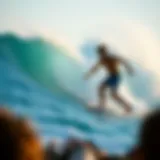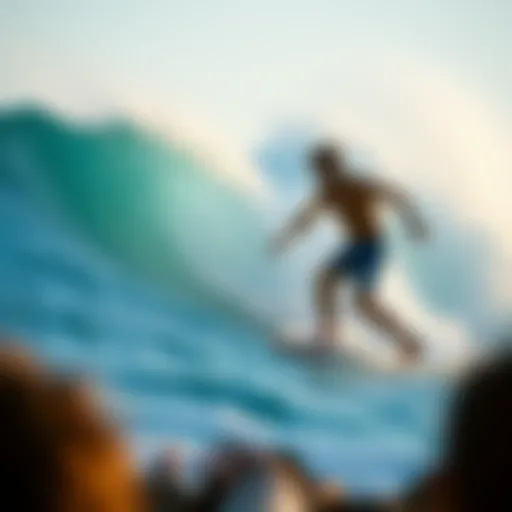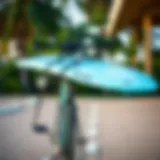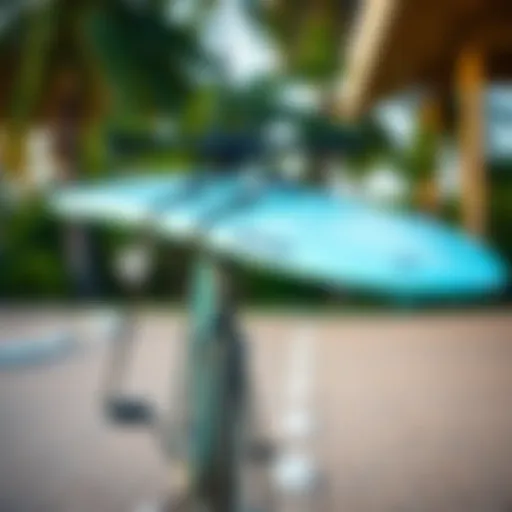Exploring the Windsurfing Scene in Miami
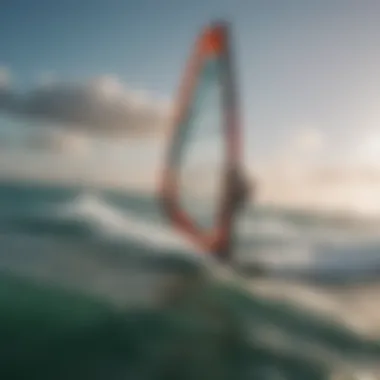

Intro
Windsurfing is more than just a sport; it’s an exhilarating lifestyle that offers a thrilling dance between water and wind. Miami, with its shimmering beaches and vibrant atmosphere, presents a paradise for windsurfing enthusiasts, both novice and experienced. The city’s unique geographical layout, coupled with its warm subtropical climate, creates exceptional conditions for this popular aquatic activity.
Not many locations can boast the same combination of consistent winds and warm waters, making Miami an attractive hub for windsurfing. Here, the winds often blow gently throughout the year, transforming routine beach outings into adrenaline-pumping adventures. As we delve deeper into the windsurfing scene of Miami, we’ll cover everything from the latest gear to essential techniques and safety tips. Strap in, as we embark on this journey through one of the world’s premier windsurfing locales.
Surf Gear and Equipment
When it comes to windsurfing in Miami, having the right equipment is pivotal. Whether you are just starting out or looking to upgrade your set, understanding the gear can make all the difference in your performance and enjoyment.
Latest Surfboard Technologies
Modern surfboards have come a long way from their traditional counterparts. Today’s boards are designed with advanced materials and technologies that enhance performance. Some notable innovations include:
- Lightweight Construction: Many boards are now made from lightweight foam, allowing for easier maneuverability. The use of carbon fiber has gained traction, providing strength without added weight.
- Hydrodynamic Shapes: Innovations in board shapes have further improved how they cut through the water. Concave, rocker, and tail designs are engineered to improve speed and stability, allowing surfers to ride waves more efficiently.
- Foil Technology: Hydrofoils have revolutionized windsurfing. They let riders glide above the water’s surface, reducing drag and providing an almost surreal riding experience. This technology is perfect for Miami’s often flat waters.
Essential Accessories for Surfers
Aside from the board itself, there are several accessories that every windsurfer in Miami should consider:
- Wetsuits: Depending on the season, a wetsuit can help keep you warm and protect your skin from sun and coral. Choose one suited to the water temperature during the time of your visit.
- Harness: A harness connects you to the sail, allowing you to exert forces without straining your arms. They come in different styles—waist and seat harnesses—each offering various levels of support and comfort.
- Personal Flotation Device (PFD): While many waves are gentle, a PFD is always wise. It boosts safety and can assist in flotation if needed.
"Having the right gear not only enhances performance but also ensures a safer, more enjoyable experience on the water."
Techniques and Skills
Mastering windsurfing isn’t solely about having the right equipment; it also requires technique and awareness of one’s surroundings. Here’s a closer look at the skills that can elevate any windsurfing adventure.
Wave Riding Strategies
Understanding how to ride waves effectively is critical for windsurfers. Here are some strategies:
- Positioning: Finding the right spot in the water where waves break can make all the difference. Position yourself just in front of the wave to prepare for the ride.
- Timing: It’s not just about where you are but when you catch the wave. Look for the right moment to angle your board and harness the wave's power.
- Balance: Maintaining a low center of gravity helps stay stable as waves grow and shift. Bending your knees and shifting your weight can help balance on choppy waters.
Safety and Surf Etiquette
Safety should always take precedence. Here are some essential points to consider:
- Know the Local Rules: Different regions may have specific rules regarding windsurfing. Always familiarize yourself with local guidelines to avoid conflicts.
- Respect Other Surfers: Avoid cutting off other surfers and give space to those riding waves. Communication and awareness can help create a friendly atmosphere on the water.
- Stay Aware of Conditions: Be mindful of changing weather and water conditions. Being caught off guard can lead to accidents or dangerous situations.
As we further explore Miami's windsurfing culture, equipment, and community, let’s keep these aspects in mind, enhancing both safety and enjoyment on the water.
The Geography of Miami: A Windsurfer's Paradise
Miami holds a special place in the hearts of water sports enthusiasts, particularly windsurfers. The city's geographical features converge to create an ideal setting for this thrilling activity. It's not just the surf and the sun; it’s about understanding how the breezy conditions, waterways, and accessibility come together to craft a unique windsurfing experience.
Optimal Wind Conditions
When we talk about windsurfing, it’s all about the wind. Miami enjoys a tropical monsoon climate, offering an array of wind conditions that can cater to both novices and seasoned riders. Typically, the trade winds blow consistently from east to east-northeast, providing ample opportunities for windsurfing activities.
From late fall to early spring, the winds tend to whip up stronger, reaching speeds that can put the more experienced windsurfers to the test. Here’s a little breakdown of the typical conditions:
- Winter Months (December to February): Winds can gust up to 20 knots, perfect for thrilling rides.
- Spring (March to May): Moderate winds between 15 to 18 knots prevail, ideal for technique improvement for upcoming riders.
- Summer (June to August): Winds calm down, averaging around 10 to 15 knots. Beginners can take full advantage of this less intense atmosphere.
- Fall (September to November): Winds pick up again, luring seasoned riders back to the water.
Water Habitats and Landscapes
Miami’s waterways present an extensive variety of collections that windsurfers can explore. The coastline is dotted with a mix of sheltered bays, open beaches, and vibrant spots that create wonderous backdrops while riding the waves. The vast shallow waters also mean that newcomers can safely practice without the fear of deep-water mishaps.
Some notable water habitats include:
- Biscayne Bay: A large shimmering expanse where gentle winds often dance across the surface.
- Key Biscayne: This barrier island provides spots with varied landscapes, from calm lagoons to more challenging waves.
- Virginia Key: A hidden gem that features both flat and choppy areas, appealing for a broad range of skills.
Even beyond just waters, the natural beauty and unique skyline of Miami makes each session memorable. The diverse marine life adds to this paradise; imagine the thrills of gliding over a sea turtle or darting past schools of fish. The interaction between the environment and the activity itself turns windsurfing into something more than just a sport.
Accessibility to Key Locations
While Miami is full of prime windsurfing spots, the ease of access into these areas is what sets it apart. The city features a grid-like structure that makes it easy for visitors to navigate and get around. Highways like I-95 and the scenic MacArthur Causeway connect major beaches to downtown and other attractions. This means you can effortlessly shift from bustling city life to serene waters without the hassle of long commutes.
Public transport options, such as buses and the Metrorail, also offer alternatives for budget-conscious surfers. In addition, various local shops and schools provide rentals and lessons within walking distance from popular beaches.


"Windsurfing in Miami is not just a sport; it's a dance with the elements, a connection to the beauty that surrounds you."
Embrace the opportunity and dive into the exhilaration that awaits!
Essential Windsurfing Gear
Windsurfing in Miami is more than just a thrilling sport; it’s a combination of skill, physics, and connection with nature. One cannot downplay the integral role of the right gear in mastering this exhilarating activity. Getting into windsurfing without the right equipment is like trying to run a marathon in flip-flops—your chances of success aren’t good. So let’s break down the essential elements of windsurfing gear and understand their significance.
Choosing the Right Board and Sail
Selecting the appropriate board and sail can make or break your windsurfing experience. It's crucial to first understand your skill level. Beginners often benefit from a wider board with more volume, as this provides greater stability. As you progress, moving to a narrower board can allow for faster speeds and more advanced maneuvers.
When it comes to sails, consider the wind conditions. In Miami, you often find varied winds throughout the year—ranging from gentle breezes to stronger gusts. Hence, having a set of sails for different wind conditions can be vital. A larger sail can capture more wind, which is beneficial for lighter winds, while a smaller sail cuts through strong winds more effectively.
"Investing in quality boards and sails is like laying a solid foundation for your windsurfing journey—it pays off in the long run."
Protective Equipment and Apparel
The right gear doesn’t stop at boards and sails; protective equipment and apparel are just as essential. Wearing a good-quality impact vest can provide crucial protection against falls. A wetsuit might be necessary too, especially during cooler months, as it not only keeps you warm but also protects from scrapes.
Additionally, don’t underestimate the importance of wearing a harness. A harness helps distribute the pull of the sail across your body instead of just your arms, making it easier to maintain your grip while maneuvering. Footstraps are just as important; they secure your feet to the board, giving you better control, especially in choppy waters.
Maintenance and Care for Equipment
Once you invest in windsurfing gear, you’ll want it to last. Maintenance isn’t just a chore; it’s a practice that enhances performance and longevity. After each session, rinse your board and sail with fresh water to remove salt and grime that can cause wear.
Check for scratches or dents that may affect your gear's performance. Simple repairs can often extend the life of your equipment significantly. Also, make sure to store your equipment correctly—avoid leaving it out in the sun for too long, and consider using a protective cover. Remember, taking care of your gear is akin to taking care of your friend; they’ll perform better when treated well.
Windsurfing Techniques: From Beginner to Advanced
Windsurfing isn’t just about being on a board with a sail gliding over water. It’s a dance between the wind, water, and your body. The techniques you adopt vastly differ based on your level, affecting how much enjoyment you get out of the sport. For beginners, mastering the fundamental techniques sets a firm foundation that allows one's skills to evolve. On the other hand, seasoned windsurfers thrive on pushing those skills further and attempting advanced maneuvers that demand not just physical exertion but a deep understanding of the elements at play.
Basic Stance and Balance
Getting your balance right is perhaps the first hurdle to surmount for any aspiring windsurfer in Miami's warm turquoise waters. The basic stance is all about having centered balance. You want to stand with your feet shoulder-width apart on the board. Imagine that your body is the wind's translator; how you position yourself directly impacts your ability to harness that energy. Bend your knees slightly and keep your weight fairly distributed. Don’t forget to hold the sail at a comfortable height.
Once you've got your feet planted, you can start practicing your balance by adjusting your body as the board reacts to the waves. It’s all about anticipating the shifts in the water and adjusting your weight accordingly. An effective way to practice this is to spend some time simply cruising along the shoreline. That initial rush can be thrilling, but remember, balance is key.
Control and Maneuvering Skills
As you get comfortable on the board, moving onto control becomes the name of the game. This involves understanding how to steer your windsurfing board. To turn right, shift your weight slightly to the right side while pulling the sail in closer to your body. For left turns, do the reverse. It can sometimes feel a bit counterintuitive, but once you get the hang of it, you’ll learn to read the wind like a book.
Furthermore, you should learn to control your speed. If you find yourself heading too quickly towards the shore, you will want to “bear off.” This maneuver involves shifting your body weight towards the back of the board and pushing the sail forward away from you. It’s a technique that can save you from an awkward tumble or crashing into the beach. Practicing figure eights in open water can be a tedious yet effective method to nail this down.
Advanced Tricks and Techniques
Once you've mastered the basics and can confidently maneuver in varying wind conditions, you’re ready to explore advanced tricks. Tricks like the gybe and tack aren’t learned overnight; they require patience and practice. A gybe involves turning downwind while keeping speed, and it can feel like a blend of art and science. Focus on your body weight and the pressure you apply to the sail; these details can create fluidity in your movement that makes for a smooth transition.
Another fascinating technique is the air jibe, where your board lifts partially out of the water for a brief moment. It’s not just about skill; it requires a good day with favorable wind conditions, like those found in Miami. Remember, safety should be your first principle in pushing the limits. Always wear safety gear, and don’t hesitate to practice out of the way of other surfers.
Practice is vital. As they say, Rome wasn’t built in a day, and windsurfing takes time to master. Stay patient, and the skills will follow.
In summary, mastering windsurfing techniques in Miami involves a journey through basic skills, control, and eventually advanced tricks. Whether you're catching your first wave or launching into a daring maneuver, each experience adds another layer to your skills on the water.
Local Windsurfing Schools and Rentals
In the vibrant windsurfing scene of Miami, local schools and rental shops play a pivotal role, bridging the gap between novices eager to learn and seasoned athletes seeking to hone their skills. These establishments enrich the community, promote safety and education, and bolster the overall enthusiasm for the sport. As the saying goes, "You can't ride a wave if you don't know how to paddle first," emphasizing the significance of proper training and access to equipment.
Overview of Windsurfing Classes
Windsurfing classes in Miami cater to a wide spectrum of skill levels, from complete beginners to those looking to master advanced techniques. Most schools offer introductory courses where students become acquainted with the windsurfing gear and basic maneuvers. Instructors break down essential concepts like balancing on the board, learning to sail upwind, and riding waves. This structured approach not only builds confidence but ensures participants understand safety protocols and environmental respect. Classes often incorporate real-time feedback, allowing students to adapt their techniques on the go.
Many schools also provide progressive levels of instruction, leading to more advanced classes for riders who have mastered the basics. These can include specialized sessions focusing on tricks, racing strategies, or even freestyle techniques.
Investing time in a structured class can drastically reduce the learning curve. What might take a self-taught individual months to grasp can often be learned in a few focused lessons under professional guidance.
Rental Shops and Equipment Availability
Finding the right rental shop is critical for anyone looking to enjoy windsurfing while visiting Miami. Fortunately, many shops dot the coastline, ensuring that gear is readily available for all skill levels. These shops often carry a broad range of boards, sails, and accessories, catering not just to the recreational windsurfer but also offering high-performance equipment for those more experienced.
It's essential to choose a rental shop that prioritizes the condition and maintenance of their equipment. Well-kept gear ensures safety and promotes an enjoyable experience. Many shops allow customers to test equipment before committing to a rental, ensuring they feel comfortable with the gear they choose.
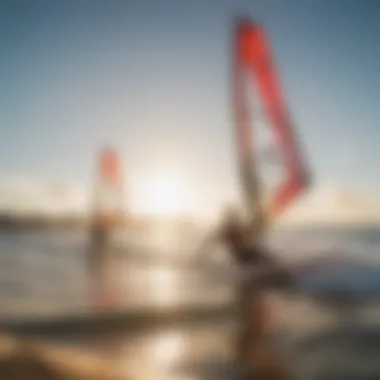

To streamline the rental process, a few points should be considered:
- Reservation System: Some shops allow for online reservations, making it easy to secure gear, especially during peak seasons.
- Variety of Options: Look for shops that offer a wide range of boards and sails to match varying conditions and riding styles.
- Expert Staff: Knowledgeable employees can provide crucial recommendations, whether you are a beginner or wanting to tackle more challenging conditions.
Certified Instructors and Their Expertise
Miami boasts a roster of certified windsurfing instructors who bring a wealth of experience and knowledge to their classes. Choosing an instructor with a recognized certification ensures that safety and effective teaching methods are at the forefront of their training practices. Many of these professionals are not just passionate about windsurfing but are also deeply invested in fostering the sport within the community.
Each instructor brings their own flavor to their teaching style, which can greatly benefit students. An experienced instructor recognizes the unique challenges each student faces, adjusting lessons accordingly. Furthermore, many certified instructors are now incorporating elements of environmental education, urging students to respect Miami's delicate ecosystems while enjoying the waters.
Working with certified instructors usually translates to:
- Structured Learning: Instructors develop a curriculum that provides a clear progression of skills.
- Immediate Feedback: Personalized feedback helps riders improve more rapidly.
- Safety First: Training with a certified professional emphasizes the importance of safety gear and practices.
In summary, local windsurfing schools and rentals in Miami are indispensable for anyone looking to dive into this exhilarating sport. With a myriad of classes offered, rental options to suit any level, and expert instructors ready to guide aspiring windsurfers, Miami nurtures a thriving windsurfing community that welcomes all.
Environmental Considerations in Windsurfing
Windsurfing is not merely a thrilling sport enjoyed on the waters of Miami; it also intertwines very closely with the environment that surrounds it. As enthusiasts glide across the waves, they must recognize how their activities impact the local ecosystem. Understanding these environmental considerations is essential for promoting responsible windsurfing practices and preserving the beauty and health of Miami's waterways for generations to come.
Impact of Wind and Water Conditions
The conditions of the wind and water are critical to the safety and enjoyment of windsurfing. However, it goes beyond that; they can also affect marine life. Strong winds can stir up sediments on the ocean floor, which may harm the delicate coral reefs that are fundamental to marine biodiversity. When the water is choppy, windsurfers need to be mindful of how their presence can disrupt the habitat of fish and other aquatic creatures.
Likewise, understanding the patterns of currents can help riders choose safe areas for practice while minimizing environmental disturbances. For instance, some waves are iconic for windsurfing, such as those at Crandon Park and Virginia Key, but the local ecosystems deserve protection too. Riders should be attuned to how their routines impact the surrounding waters, creating a harmonious balance between sport and the environment.
"Windsurfers have a unique opportunity to be stewards of the waters they love by maintaining awareness of their impact on local wildlife, they can ensure a sustained experience for all."
Conservation Efforts and Sustainable Practices
In the face of climate change, Miami's windsurfing community has increasingly recognized the need for conservation efforts. Many local groups advocate for responsible use of marine resources, while also organizing beach clean-ups and awareness campaigns. Their initiatives go a long way toward protecting fragile coastal areas that windsurfers often frequent.
A few sustainable practices to consider include:
- Eco-Friendly Gear: Opt for gear made from sustainable materials. Some companies focus on producing windsurfing equipment with lower environmental footprints.
- Respecting Restricted Zones: There are areas around Miami that are designated as sanctuary zones to preserve marine life. Knowledge and respect for these zones can significantly contribute to marine conservation efforts.
- Educating Others: Share knowledge about the importance of protecting marine ecosystems amongst fellow windsurfers and the general community. Advocacy can create a ripple effect, leading more individuals to adopt sustainable practices.
Through these efforts, the windsurfing culture in Miami can intertwine its love for sport with a commitment to environmental stewardship. It is about enjoying the ride while ensuring that the vibrant ecosystems remain intact for every windsurfer who seeks the thrill of the waves.
Cultural Aspects of Windsurfing in Miami
Windsurfing in Miami is not merely a sport; it's an intricate tapestry woven with pieces of local culture, community values, and shared experiences. The cultural aspects of windsurfing underscore the vibrancy and diversity of Miami's aquatic playground. This section will illuminate how events, trends, and individual stories converge to create a dynamic and engaging windsurfing community.
Community Events and Competitions
Miami is alive with community events centered on windsurfing. These gatherings are more than just competitions—they represent a chance for surfers of all levels to come together, share their passion, and learn from one another. From local regattas held at spots like Crandon Park to larger competitions that draw participants from all over the globe, these events foster camaraderie among enthusiasts.
There are also workshops and clinics designed for budding windsurfers. People come to develop skills, meet instructors, and participate in friendly competitions. The excitement is palpable; you can see sheer joy on the faces of those who succeed in executing their first tack or jibe.
Popular local events include:
- The Miami Windsurfing Cup: This annual event showcases top talents and attracts sponsors.
- Fun Days at Hobie Beach: Open to everyone, this event encourages all skill levels, boasting a relaxed vibe suited for beginners.
"We share a love for the wind and water. Every event is a reminder of why we do what we do, and it’s just the energy of the community that keeps us coming back!"
— A Miami-based windsurfer.
Local Influences and Trends
The local windsurfing scene is shaped by Miami’s unique cultural blend. Influences from Caribbean, Latin, and American cultures create a distinct environment, reflected in both techniques and styles. The sport evolves as local riders bring elements from different traditions, leading to innovative approaches to windsurfing.
Social media plays a vital role, giving rise to trends that spread like wildfire among the windsurfing community. Riders often share their adventures on platforms like Instagram and Reddit, showcasing new techniques, picturesque spots, and gear review. As trends shift, so do the preferences for types of boards and sails, aligning with the community's evolving tastes and technological advancements.
Key trends in the Miami windsurfing culture:
- Emphasis on eco-friendly practices, with more riders opting for sustainable gear.
- Popularity of freestyle disciplines, especially among younger surfers eager to showcase their skills.
Profiles of Notable Windsurfers
Every community has its stars, and Miami windsurfing is no exception. Inspiring figures have emerged, each with unique backgrounds and accomplishments. These individuals not only excel on water but also engage with the community, fostering growth and passion among newer surfers.
For instance, Marsha Lopez, a Miami native, has made waves both locally and internationally. With her vibrant personality, she’s not just known for her impressive skills but also for actively mentoring young riders and promoting windsurfing awareness.
Other notable figures include:
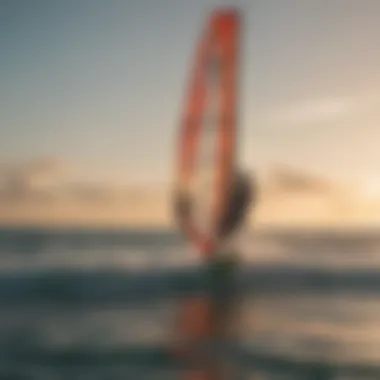

- Daniel Rivera, an athlete who holds several championship titles and extensively supports local initiatives.
- Clara Chan, a trailblazer for female windsurfers, who encourages inclusivity within the sport.
The stories of these athletes provide insights into how dedication can shape not only personal success but also the community’s identity.
Windsurfing-Friendly Beaches in Miami
Windsurfing in Miami is more than just a sport; it’s a lifestyle. The city's coastlines boast a variety of beaches perfectly tailored for windsurfing enthusiasts, ranging from beginners eager to catch their first gust to seasoned veterans looking for challenging conditions. In this section, we will explore the distinct characteristics of these beaches, their advantages, and the considerations involved in selecting the best spots for windsurfing.
Top Spots for Beginners
For those who are new to windsurfing, finding the right location can make all the difference. Several beaches in Miami are particularly conducive for novices, giving them the chance to learn and practice with more confidence:
- Haulover Beach Park: Known for its shallow waters and consistent winds, Haulover is a favorite among beginners. The beach has ample space and is patrolled by lifeguards — providing a sense of safety while learning.
- Virginia Key Beach: This area offers a stunning backdrop with golden sand and friendly waters. The gentle waves make it a suitable choice for newcomers exploring their balance on the board.
- Matheson Hammock Park: A little less crowded, this spot boasts pristine views and flat waters, ideal for practicing basic skills without the interference of strong currents.
When embarking on your learning journey, remember to check the local weather patterns. Wind conditions can change daily, and catching the right wind at the right time is crucial to becoming proficient.
Challenging Locations for Experienced Riders
Once you’ve mastered the basics, Miami has no shortage of spots that offer a thrill for seasoned windsurfers. Here are a few locations known for their challenging conditions:
- Crandon Park: Located on Key Biscayne, this park is popular for its stronger winds and waves. It presents a good test of skill, particularly for those looking to refine their techniques and tackle trickier maneuvers.
- Miami Beach: A bustling environment with lively waters, Miami Beach also offers conditions that can challenge even the most experienced. Taking on the bustling beach crowd while managing the wind and waves keeps riders on their toes.
- Biscayne Bay: For those seeking a taste of something different, Biscayne Bay can provide gusty winds ideal for high speeds and complex tricks. This area is particularly vibrant and often sees many experienced windsurfers ready to showcase their capabilities.
Safety and Regulations at Each Beach
Safety should never take a back seat when enjoying windsurfing in Miami. Each beach comes with its own set of regulations, which are designed to protect both surfers and the local environment:
- Adhere to designated zones: Always check for signs indicating windsurfing zones. Staying within these limits not only ensures your safety but also protects the habitats of marine life in the area.
- Know your leash laws: Many beaches require the use of a leash while windsurfing, particularly in busy areas. This helps in preventing equipment loss and maintaining safety for others.
- Check local guidelines: Regulations can vary by beach, so it’s advisable to familiarize yourself with any specific rules related to water sports. Be mindful of local wildlife and designated conservation areas—protecting the environment should always be a priority.
"The best winds of change can often be found in the waters of Miami's beaches; choosing the right one is half the battle."
Engage with fellow surfers on platforms like reddit.com or facebook.com to discover more about Miami’s windsurfing community.
Seasonal Trends and Best Times to Visit
Understanding the seasonal trends and the optimal times for windsurfing in Miami is essential for enthusiasts and newcomers alike. Miami's unique climate style, coupled with its geographical features, creates certain patterns that every windsurfer should be aware of. Recognizing these nuances ensures a more enjoyable and successful experience on the water.
Understanding Miami's Climate for Windsurfing
Miami boasts a tropical monsoon climate, characterized by warm temperatures year-round, which is a major draw for windsurfing aficionados. The average highs hover around 80°F (27°C), with summer months peaking higher, often reaching into the 90s (32°C+). A noteworthy aspect is the breezy conditions prevalent here, typically influenced by trade winds.
- Trade Winds: These consistent winds blow from the east, making it a prime location for windsurfing. The typical wind speeds vary from 10 to 20 knots, fluctuating depending on the time of year.
- Rainy Seasons: From May to October, Miami experiences its rainy season. It’s essential to keep an eye on afternoon thunderstorms during these months, which could potentially disrupt your windsurfing plans.
- Winter Breeze: Between November to April, the cool fronts sweep in from the north, bringing steadier winds that can be more predictable. Many locals consider this the golden period for windsurfing.
In short, the climate is friendlier and more stable during the winter months, transforming Miami into a windsurfer's playground.
Peak Windsurfing Seasons Explained
Identifying the peak windsurfing seasons in Miami allows surfers to harness the best possible conditions available throughout the year. Generally, the ideal times can be segmented into two main periods:
- Winter Season (November to April)
This is widely regarded as the best time for windsurfing. The combination of strong winds and cooler temperatures creates a refreshing environment. The north winds lend themselves to excellent conditions for all skill levels. - Summer Season (May to October)
While the summer isn't as consistently windy, it brings unique opportunities for those willing to adapt. Winds can be lighter, but sustained breezes in the morning still allow for enjoyable sessions. Familiarization with weather patterns becomes crucial.
- Warm-up Events: Many local competitions and events are arranged during this season, attracting national and international talents.
- Afternoon Storms: Be mindful of sudden weather changes, as storms can arise quickly. It pays to be prepared and check forecasts ahead of time.
In the end, having a grasp on seasonal trends can be the difference between a lackluster windsurfing experience and one that leaves lasting memories. By aligning personal schedules with the climate and conditions, every windsurfer—be they novice or pro—can optimize their time on the water.
The Future of Windsurfing in Miami
As Miami continues to establish itself as a haven for windsurfing enthusiasts, understanding the future of this sport in the region is essential. The growth in participation rates, the evolution of technology, and community engagement are shaping the landscape of windsurfing in ways not seen before. This section dives into two critical components: emerging technologies and the growth of local communities, examining how these elements influence the overall windsurfing experience.
Emerging Technologies and Innovations
The windsurfing scene in Miami is on the verge of a technological boom. Recent innovations have been making waves, quite literally, as new gear enables surfers to enhance their performance. Boards now come equipped with lightweight materials, such as carbon fiber, making them easier to maneuver. Sails have also evolved. Recent models often feature advanced designs that optimize aerodynamics, allowing for better speed and control in various wind conditions.
But it's not just equipment. Technology is also changing how surfers interact with the wind and water. Smart devices, like GPS-enabled watches and apps, are giving riders access to real-time weather data. This allows them to choose the best times to hit the water, avoiding those unpredictable gusts that can catch even seasoned windsurfers off guard. There's plenty of chatter on forums like reddit.com about how these advancements can dramatically improve the overall windsurfing experience.
"Emerging technologies are turning windsurfing into a data-driven sport, where knowing the wind patterns can be just as crucial as the skills you bring on the board."
Community Growth and Engagement
The windsurfing community in Miami is not merely growing in numbers; it is also fostering a spirit of camaraderie that enhances the experience for all. Local clubs and associations are capitalizing on this momentum, hosting events that bring enthusiasts together. Beach cleanups and competitions, both formal and informal, are part and parcel of this vibrant culture. Such initiatives not only engage seasoned surfers but also invite newcomers, thus allowing them to learn and share experiences together.
The increasing interest in windsurfing also leads to partnerships with schools and organizations focused on water sports. Young talent is continually being nurtured through educational programs, both practical and theoretical, ensuring that the sport remains alive and thriving for generations to come. The social media groups dedicated to windsurfing in Miami are gaining traction, creating platforms for enthusiasts to share tips, tricks, and stories that resonate across all levels of expertise.
This community spirit isn’t just about the joy of riding waves; it’s also about a shared responsibility to protect the beautiful waters of Miami. Environmental advocacy is taking firm root within these circles, promoting sustainable practices that preserve the conditions that make Miami a windsurfing destination.
As the sporting landscape evolves, the synergy between technology and community will shape the future of windsurfing in Miami, ensuring it remains accessible, exciting, and environmentally mindful.


